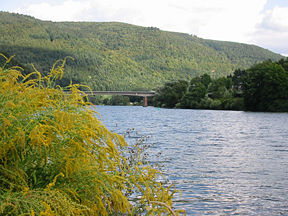Neckar
| Neckar | |
|---|---|
 |
|
| Origin | Black Forest |
| Mouth | Rhine |
| Basin countries | Germany |
| Length | 367 km |
| Source elevation | 706 m |
| Avg. discharge | 145 m³/s |
| Basin area | ±14,000 km² |
The Neckar is a 367-km long river, mainly flowing through the southwestern state of Baden-Württemberg, but also a short section through Hesse in Germany, a major right tributary of the River Rhine, which it joins at Mannheim. Rising in the Black Forest near Villingen-Schwenningen in the conservation area Schwenninger Moos at a height of 706 m above sea level, it passes through Rottweil, Rottenburg am Neckar, Tübingen, Nürtingen, Plochingen, Esslingen, Stuttgart, Ludwigsburg, Marbach, Heilbronn and Heidelberg, before discharging into the Rhine at Mannheim (at 95 m above sea level).
Along its valley in the Odenwald hills, many castles can be found, like Burg Hornberg and Burg Guttenberg in Haßmersheim, but also the closed Obrigheim Nuclear Power Plant. After passing Heidelberg, the Neckar discharges on average 145 m³/s of water into the Rhine, which makes the Neckar its 4th largest tributary, and the 10th largest river in Germany.
The name Neckar was derived from Nicarus and Neccarus from Celtic Nikros, meaning wild water or wild fellow. Since about 1100, Black Forest wood was transported by timber rafting, e.g. to Holland for the use in shipyards.
During the 19th century, traditional horse-drawn boats were replaced by steam boats that used a 155-km long chain in the river to pull themselves upstream. The railway made it possible to transport timber to the port of Heilbronn, limiting timber rafting to the lower part of the Neckar after 1899. Thanks to the construction of 11 locks, ships up to 1500t could travel to Heilbronn in 1935.



By 1968, the last of 27 locks, at Deizisau, was completed, making the Neckar navigable for cargo ships about 200 km upstream from Mannheim up to the river port of Plochingen, where the Fils joins, and where the Neckar bends, taking a Northwestern instead of a Northeastern direction. Other important ports include Stuttgart, Heilbronn and Mannheim.
The river's course provides a popular route for cyclists, especially during the summer months. Its steep valley sides are used as vineyards, to cultivate mainly Trollinger.
Towns along the Neckar
From its source to its confluence with the Rhine:
- Villingen-Schwenningen
- Rottweil
- Oberndorf am Neckar
- Sulz am Neckar
- Horb am Neckar
- Rottenburg am Neckar
- Tübingen
- Nürtingen
- Plochingen
- Esslingen (am Neckar)
- Stuttgart
- Fellbach
- Ludwigsburg
- Freiberg am Neckar
- Benningen am Neckar
- Marbach am Neckar
- Besigheim
- Lauffen am Neckar
- Heilbronn
- Neckarsulm
- Bad Wimpfen
- Mosbach
- Eberbach
- Heidelberg
- Mannheim
Main tributaries
- Eschach (left side, at Rottweil-Bühlingen)
- Ammer (left side, at Tübingen-Lustnau)
 The River Körsch, a tributary, flows into the Neckar opposite the Altbach power station
The River Körsch, a tributary, flows into the Neckar opposite the Altbach power station - Echaz (right side, at Kirchentellinsfurt)
- Lauter (right side, at Wendlingen)
- Fils (right side, at Plochingen)
- Nesenbach (left side, at Stuttgart-Ost)
- Rems (right side, at Remseck)
- Murr (right side, at Marbach)
- Enz (left side, at Besigheim)
- Zaber (left side, at Lauffen)
- Sulm (right side, at Neckarsulm)
- Kocher (right side, at Bad Friedrichshall)
- Jagst (right side, at Bad Wimpfen)
- Elz (right side, at Mosbach-Neckarelz)

External l inks
|
||||||||||
